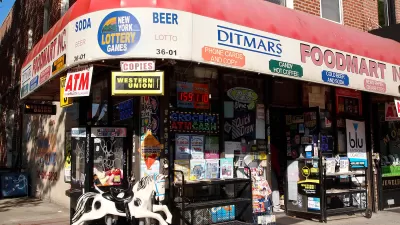A new report examines how high rents are shuttering businesses and stunting entrepreneurship, exploring six strategies used by cities to create an affordable built environment, where local businesses can thrive.
The cost of leasing commercial space is soaring in many U.S. cities, and posing an increasing threat to the future of independent businesses, the Institute for Local Self-Reliance finds in a report released Wednesday. In cities as diverse as Oakland and Nashville, Milwaukee and Portland, Maine, retail rents have shot up by double-digit percentages over the last year alone. As the cost of space rises, urban neighborhoods that have long provided the kind of dense and varied environment in which entrepreneurs thrive are becoming increasingly inhospitable to them. Local businesses that serve the everyday needs of their communities are being forced out and replaced by national chains that can negotiate better rents or afford to subsidize a high-visibility location.
ILSR's new report examines what's causing commercial rents to skyrocket, and explores six broad policy strategies that elected officials and community leaders are proposing to address it. There's a public interest in the commercial side of the built environment, the report argues, and smart city policy has an important role to play in creating an urban landscape in which locally owned businesses can thrive.
Among the examples in the report are Salt Lake City’s investigation into creating a “Buy Your Building” program to help local businesses purchase their property, New York City’s efforts to give small business owners certain rights when it comes time to renew their leases, San Francisco’s ordinance encouraging commercial diversity, and Seattle’s plans to lease city-owned property to local businesses with favorable terms.

Alabama: Trump Terminates Settlements for Black Communities Harmed By Raw Sewage
Trump deemed the landmark civil rights agreement “illegal DEI and environmental justice policy.”

Planetizen Federal Action Tracker
A weekly monitor of how Trump’s orders and actions are impacting planners and planning in America.

Why Should We Subsidize Public Transportation?
Many public transit agencies face financial stress due to rising costs, declining fare revenue, and declining subsidies. Transit advocates must provide a strong business case for increasing public transit funding.

Understanding Road Diets
An explainer from Momentum highlights the advantages of reducing vehicle lanes in favor of more bike, transit, and pedestrian infrastructure.

New California Law Regulates Warehouse Pollution
A new law tightens building and emissions regulations for large distribution warehouses to mitigate air pollution and traffic in surrounding communities.

Phoenix Announces Opening Date for Light Rail Extension
The South Central extension will connect South Phoenix to downtown and other major hubs starting on June 7.
Urban Design for Planners 1: Software Tools
This six-course series explores essential urban design concepts using open source software and equips planners with the tools they need to participate fully in the urban design process.
Planning for Universal Design
Learn the tools for implementing Universal Design in planning regulations.
Caltrans
Smith Gee Studio
Institute for Housing and Urban Development Studies (IHS)
City of Grandview
Harvard GSD Executive Education
Toledo-Lucas County Plan Commissions
Salt Lake City
NYU Wagner Graduate School of Public Service





























